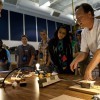Abstract
STEM is an acronym for science, technology, engineering, and math. In Extension, our purpose is to share the knowledge or products created through Ag-STEM research and design by universities and government agencies. Finding effective solutions to agricultural issues, especially in urban areas, increasingly involves working with clientele to solve problems jointly. Therefore, emphasizing the connections of STEM to agricultural problems through Ag-Extension programming can help our public audiences comprehend the problem-solving system underlying the content. The goal is to provide public audiences with self-confidence and skills in STEM, preparing them to be more engaged in the problem-solving process for the challenges ahead. This 5-page fact sheet was written by Kathryn A. Stofer, Laura A. Warner, and Steven Arthurs, and published by the UF Department of Agricultural Education and Communication, October 2014. (UF/IFAS photo by Tyler Jones.)
References
Carnevale, A. P., Smith, N., & Melton, M. (2011). STEM: Science, Technology, Engineering, Mathematics. Washington, DC: Georgetown University Center on Education and the Workforce.
Gerlach, J. (2012, April 11). STEM: Defying a simple definition. NSTA WebNews Digest. Retrieved June 24, 2014, from http://www.nsta.org/publications/news/story.aspx?id=59305
Hillison, J. (1996). The origins of agriscience: Or where did all that scientific agriculture come from? Journal of Agricultural Education, 37(4), 8-13. https://doi.org/10.5032/jae.1996.04008
Knowles, M. S., Holton, E. F., III, & Swanson, R. A. (2005). The Adult Learner (6th ed.). San Diego, CA: Elsevier. https://doi.org/10.4324/9780080481913
Langdon, D., McKittrick, G., Beede, D., Khan, B., & Doms, M. (2011). STEM: Good jobs for now and the future. (U.S. Department of Commerce, Economics and Statistics Administration Issue Brief No. ESA Issue Brief #03-11). Washington, DC: United States Department of Commerce.
National Academy of Engineering & National Research Council (U.S.). (2014). STEM integration in K-12 education: Status, prospects, and an agenda for research. Washington, D.C.: The National Academies Press. Retrieved from http://www.nap.edu/catalog.php?record_id=18612
United States. Congress. Joint Economic Committee Chairman. (2012). STEM Education: Preparing for the Jobs of the Future. Washington, DC: 112th Congress. Retrieved from http://www.jec.senate.gov/public/index.cfm?a=Files.Serve&File_id=6aaa7e1f-9586-47be-82e7-326f47658320
University of Florida. (2013). Shaping Solutions for Florida's Future: The UF/IFAS Extension Roadmap 2013-2023. Gainesville, FL.

